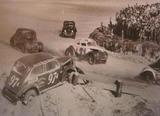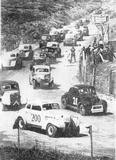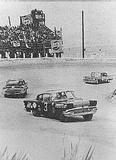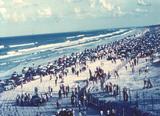
1958 Ragtop Start
Lee Petty and Tim Flock occupy the front row at the start of the 160-mile NASCAR Convertible Division championship race on February 22, 1958. NASCAR conducted a separate series for the Ragtop racers from 1956-1959. With the unveiling of the new Daytona Int'l Speedway in 1959, the Convertible cars were nearly 15 mph slower than their hardtop counterparts. The series was phased out after the 1959 season.

Broken Barrier
Tommie Elliott breaks through the wooden retaining barrier in the North Turn during the 1954 Modified-Sportsman race at Daytona. Wooden boards were hardly capable of containing speeding race cars, but there were relatively few spectator injuries during the tenure of the Beach-Road course.

Aerial View
An aerial panoramic view of the spectacular Road-Couse in Daytona, with the tide at its ebb and a mile of race cars prowling up the beach moments before the start of a race. The Beach-road course was located at the southern tip of Ponce Inlet. The final stock car race was staged on Febryary 23, 1958. Curiously, the concrete blocks that held the South turn grandstands are still in the ground today.

Earnhardt On Sand
Ralph Earnhardt's #200 Chevrolet on the pace lap of the 1956 Modified-Sportsman race at Daytona. Earnhardt was in a conventional Sportsman Chevrolet, facing huge obstacles when racing again the unrestrained Modifieds. Yet, Earnhardt finished 8th in the Sportsman class and 17th overall in the 100-mile event.

Triumphant Finale
Paul Goldsmith whips Smokey Yunick's Pontiac through the North Turn in the 1958 Daytona Beach Grand National with Curtis Turner and Jack Smith in hot pursuit. Goldsmith started on the pole and drove to victory in the final NASCAR stock car event staged over the magnificent Oceanside Speedway.

Spectator Participation
One of the high-lites of Daytona's Speedweek was the Century Club runs and the Performance trials, where casual spectators had an opportunity to make speed runs through the Measured Mile. Those piercing the timing wires over 100 mph received membership and a certificate in the Century Club.

Speed Trap
The automotive boneyard just off the outer crest of the South Turn was heavily occupied during the 1955 Sportsman race. Following a speedy two-mile pilgrimage down the paved backstretch, making the hair-pin South Turn was a critical maneuver. Quite often, drivers would carry the momentum too far into the corner and wind up in the boneyard.

Fireball and Banjo
Fireball Roberts #M-3 and Banjo Matthews #49jr. pair up in the North Turn in the 1955 Modified-Sportsman race. Roberts was driving a '37 Chevrolet packed with a souped up 1954 Cadillac engine. Team owner Bob Fish affectionately called it a "Chevrolac". Matthews was in a '40 Ford owned by Melvin Joseph and wrenched by Joe Wolfe. Roberts led from the outset until his engine blew. Matthews picked up the pace and drove to victory.

Fabulous Hudson Hornet
Marshall Teague, one of NASCAR's early greats, glides his Fabulous Hudson Hornet into the North Turn en route to victory in the 1951 Grand National event. He came back the following year and won it again. Teague was responsible for Hudson Motor Co becoming involved in NASCAR stock car racing from a factory standpoint. They were perhaps the first manufacturer to reap rewards from winning major stock car races.

Big Hugo
Hugh Lanford hustles his Ford into the North turn, kicking up sand from the right rear tire in the July 27, 1941 Race on Daytona's Beach-Road course. Lanford, one of the regulars in Daytona racing prior to the War,
finished sixth in the race.

Going Home
Thousands of cars stream Northward along the shoreline, beginning their exodus home following a dynamic day at the Daytona races. With the narrow 2-land A-1-A highway serving as the only public road to the speedway, most spectators hustled out onto the course and drove up the beach. Quite often, the race home was as adventuresome as the races themselves.



Sign My Guestbook
 View My Guestbook
View My Guestbook


























